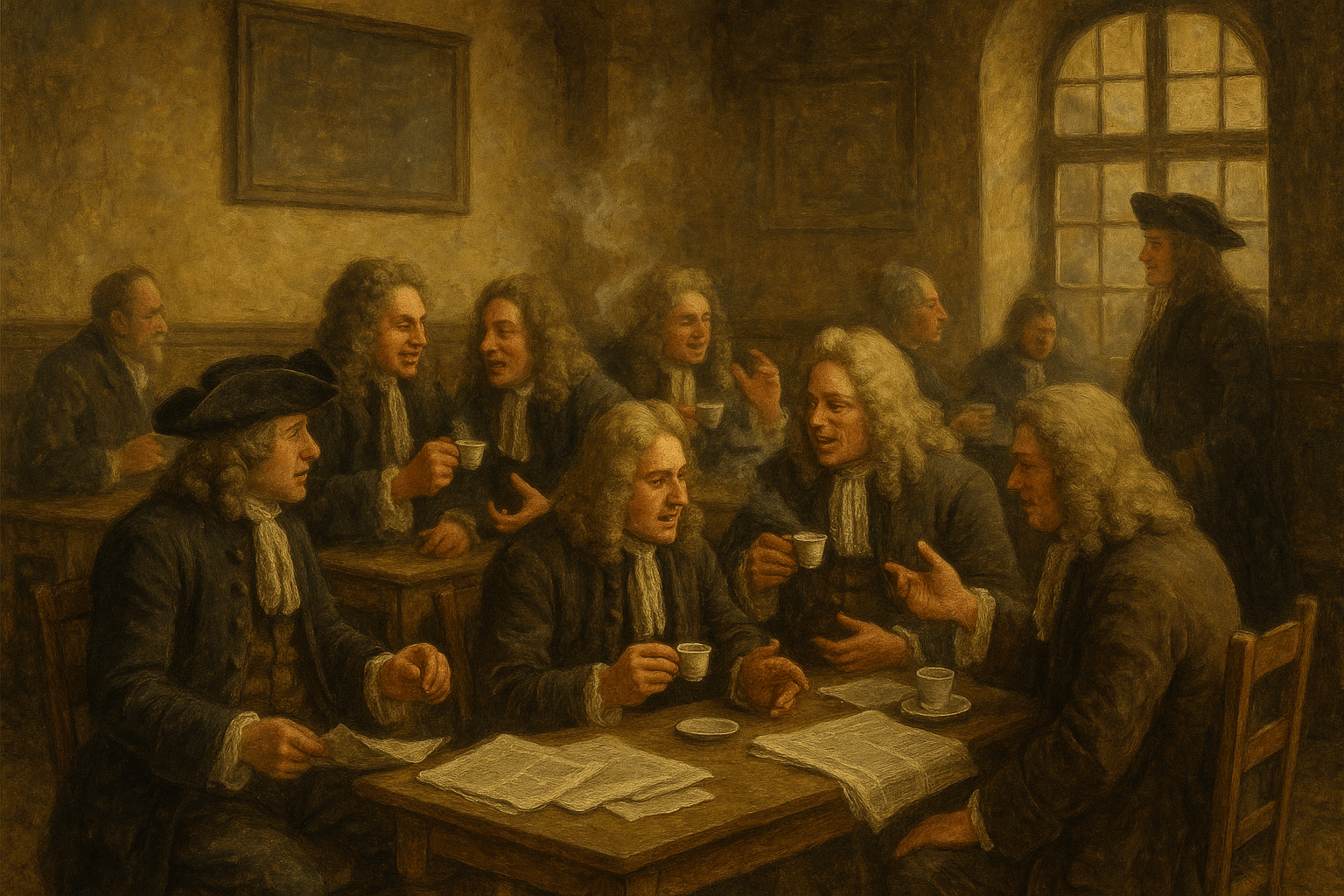From Boozy Haze to Sobering Clarity
To understand coffee’s revolutionary impact, we must first picture the world it entered. In 17th-century Europe, the drink of choice for nearly everyone, from dockworkers to dukes, was alcohol. Water was often contaminated and unsafe to drink, so people hydrated with weak beer (“small beer”) or wine from morning till night. The result was a society functioning under a constant, low-grade state of inebriation. It was a world of foggy minds and sluggish afternoons.
Then came coffee. Arriving from the Ottoman Empire, this new drink was a revelation. It was hot, bitter, and, most importantly, it was a stimulant, not a depressant. Instead of dulling the senses, it sharpened them. It promoted alertness, focus, and rational thought. As one writer of the period noted, coffee was “this little black bean, which is said to have the property of making a man wise.” It was, in effect, the perfect antidote to the alcoholic haze that had enveloped society.
The Penny Universities: London’s New Public Sphere
The true power of coffee was unlocked in the unique establishments that served it: the coffeehouses. The first one in London was opened in 1652 by Pasqua Rosée, and the concept spread like wildfire. By the turn of the 18th century, London boasted over 500 of them. They quickly earned an illustrious nickname: “Penny Universities.”
The name was fitting. For the price of a penny—the cost of a dish of coffee—any man could gain entry. Inside, social status was secondary to the quality of one’s arguments. Merchants, clerks, scientists, writers, and politicians all mingled in a stimulating environment of debate and discussion. Unlike the exclusive court or stuffy university halls, the coffeehouse was a democratic space where ideas could be freely exchanged and challenged.
These were not quiet, studious cafés. They were bustling, chaotic hubs of information, filled with the clatter of cups, the haze of tobacco smoke, and the constant hum of conversation. Runners would dash in with the latest news from Parliament or the shipping docks, and handwritten newsletters were passed from table to table. The coffeehouse became the crucible of public opinion, an entirely new “public sphere” where citizens could form and debate ideas outside the direct control of the monarchy or the church.
Cauldrons of Commerce and Science
Different coffeehouses soon began to attract specific clienteles, evolving into specialized centers for commerce and intellectual inquiry. This is where the Age of Reason was truly put into practice.
- Lloyd’s Coffee House: Initially a modest spot on Tower Street frequented by sailors, ship captains, and merchants, Lloyd’s became the go-to place for reliable shipping news. This exchange of information on everything from weather patterns to pirate threats led to a more formalized system of sharing risk. Merchants began underwriting voyages for a fee, a practice that evolved into marine insurance. That coffeehouse eventually grew into the world’s leading insurance market, Lloyd’s of London.
- Jonathan’s Coffee-House: In Change Alley, another coffeehouse became the center for a different kind of speculation. Here, “stock-jobbers” gathered to trade shares and commodities. The frenetic buying and selling at Jonathan’s laid the foundation for what would become the London Stock Exchange.
- The Grecian Coffee House: This was the preferred haunt of the “virtuosi”—the scientists and intellectuals of the day. Members of the prestigious Royal Society, including Sir Isaac Newton and Sir Hans Sloane, gathered here to debate scientific theories and discoveries. Legend has it that Newton once dissected a dolphin on one of its tables to settle a debate, perfectly capturing the spirit of empirical curiosity these places fostered.
Parisian Cafés and the Seeds of Revolution
Across the Channel in Paris, coffeehouses played an equally transformative, if more overtly political, role. Places like the iconic Café Procope, founded in 1686, became the headquarters for Enlightenment thinkers. Here, Voltaire, Rousseau, and Diderot debated the nature of liberty, man, and government, with Diderot allegedly conceiving parts of his monumental Encyclopédie amidst the café’s lively chatter.
These Parisian cafés were hotbeds of radical thought and political dissent. Benjamin Franklin was a frequent visitor during his time as American ambassador, gathering support and sharing revolutionary ideals. Decades later, the ideas that had simmered over countless cups of coffee would boil over. On July 12, 1789, a young lawyer named Camille Desmoulins leaped onto a table at the Café de Foy and delivered a fiery speech that inspired the storming of the Bastille, an event that triggered the French Revolution.
A “Vile, Bitter” Threat to the Old Order
Naturally, this new culture of sober debate and free thought was seen as a threat by the establishment. Rulers and traditionalists viewed these “seminaries of sedition” with deep suspicion. In 1675, King Charles II of England issued a “Proclamation for the Suppression of Coffee Houses”, decrying them as places where false and malicious reports “are devised and spread abroad, to the Defamation of His Majesty’s Government.” The public outcry was so immense that he was forced to retract the ban within two weeks.
Even a satirical “Women’s Petition Against Coffee” was published in 1674, humorously complaining that the drink made men “unfruitful” and led them to “babble” about news and neglect their duties at home. While intended as a joke, it highlights how profoundly the coffeehouse had altered social habits.
The Legacy in Your Cup
From fueling the birth of modern finance at Lloyd’s to sharpening the minds that would define the Enlightenment, coffee and the coffeehouse were instrumental in forging the modern world. They replaced an alcoholic stupor with caffeinated debate, creating the physical and mental space for reason, commerce, and revolution to flourish.
So the next time you step into a coffee shop, with its buzz of conversation and laptops flickering like modern-day newsletters, take a moment. You’re participating in a tradition that’s over 350 years old—one that helped uncork the very spirit of intellectual curiosity and progress that defines our age.
